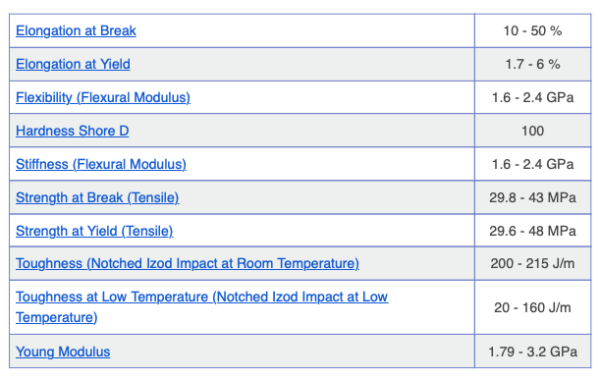Inside Materials – ABS

ABS, a lightweight yet tough polymer, plays a crucial role in the plastics industry.
Borg-Warner Corporation introduced Acrylonitrile Butadiene Styrene (ABS), an amorphous engineering thermoplastic, to the market in 1954. Since then, ABS has become essential across industries for its unique blend of properties. Today, manufacturers produce over 6,000 grades, ensuring its adaptability to diverse applications.
You can also read: Inside Materials – PVDC
Outstanding Properties
Engineers recognize ABS as a standout material due to its composition. It combines polybutadiene’s resilience with the hardness of polyacrylonitrile and polystyrene. This combination has exceptional physical and mechanical properties, including high impact resistance, superior abrasion and strain resistance, and excellent dimensional stability. Its smooth surface finish, weldability, and electrical insulating properties further broaden its appeal.

ABS’ mechanical properties. Courtesy of Omnexus.
Manufacturing Processes and Applications
Industries leverage ABS through various processing methods, including injection molding, extrusion, 3D printing, and blow molding. These techniques enable its widespread use in appliances, automotive components, electronics, consumer goods, and construction materials. For instance, ABS forms the sturdy shells of electronic devices and durable automotive trims, demonstrating its versatility.

ABS products. Courtesy of SENTEZ Optimum Kimya.
ABS’ Recycling Innovation
In 2024, TNO and ELIX Polymers introduced an innovative recycling technology that advances ABS’s sustainability. Their dissolution process uses solvents to recover high-quality polymers from post-consumer plastics, consuming less energy than chemical recycling. This method effectively removes contaminants like pigments and additives, producing recycled ABS suitable for high-value applications. A notable success includes integrating recycled ABS into products like washing machine components, reducing waste while maintaining quality.

Application of dissolution process for circular ABS plastic recycling. Courtesy of TNO.
A pilot plant in the Netherlands now supports further scaling of the project, positioning this technology as a sustainable solution for the ABS industry.
You can also read: Recycled ABS Contributes to a More Sustainable Shower
Industry Leaders
In addition to TNO, leading manufacturers such as LG Chemicals, Asahi Kasei, CHIMEI, and Formosa Plastics also drive ABS innovation. Their efforts ensure a steady supply of high-performance materials worldwide.
With its exceptional performance, adaptability, and ongoing advancements in recycling, ABS remains a commodity material for modern engineering and design.
